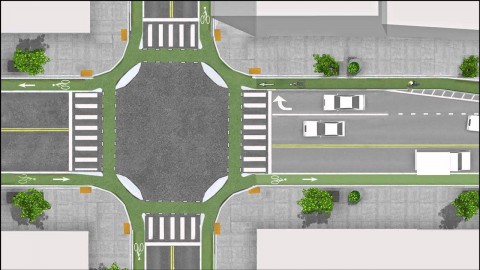
The Dutch experience of urban design for cycling
A synopsis of a talk by Netherlands Ambassador Rob Zaagman
March 2018, Wellington
“Cycling is a way of life in the Netherlands”.
But until the 1980s transport provisions for cars in Holland, just as in New Zealand, had priority over cycling and walking.
Cycling after WWII in Holland was in steep decline.
That was all changed with the "Stop de Kindermoord" ("Stop the Child Murder") campaign following 450 child road deaths in 1973.
Dutch cities and towns have been transformed into more liveable attractive places.
(See how public attitudes to cycling were transformed http://www.aviewfromthecyclepath.com/2011/01/stop-child-murder.html )
Some interesting facts about cycling in the Netherlands detailed by Mr Zaagman:
84% of people own a bike
There are 23 million bikes owned by Holland’s 17 million people
There are 3 times more bikes than cars
A quarter of all traffic movements are done by bicycle
A quarter of all commuters travel by bike
Over half of all children go to school by bike (only possible because cycling is safe)
Cycling culture starts with bike lessons at school
Holland has 35,000 km of cycleways
It has 6,000 km of fast cycleways (cycle highways)
In 1989 transport authorities gave cycling equal status with other transport modes in planning and spending
Holland spends $600m/year on cycling policy and infrastructure
Amsterdam spent $25-30m/year on cycling infrastructure and policy from 2007-10
Cycling infrastructure spend benefits are three times spending on trains or cars
Zaagman’s cycle planning and design principles
The most important thing is that cycleways are connected, safe and accessible
Safety is the key – when separation is impossible, traffic speed must be limited to below 30km
The network must be extensive and interconnected
“It doesn’t help you if you are on cycle path and all of a sudden it ends and you are in the middle of nowhere”.
Urban planning must take account of cycling
Cycle paths have to allow fast, safe commuting
When sharing space with cars, bike lanes have to be clearly recognisable
Contact moments should be limited
Existing roads often need to be redesigned, intersections must be made cycle-friendly
How a Dutch Cycle-friendly intersection looks (above)
See how it used to be and how it now is https://www.youtube.com/watch?v=FlApbxLz6pA
Laws should protect cyclists – any collision between a motorist and cyclist is the fault of the motorist unless proven otherwise
Helmets are not necessary if cycleways provide safe passage and may hinder cycling take-up
Loss of parking due to building cycleways in practice has invariably improved business for local businesses
To view the talk go to: https://www.youtube.com/channel/UC1jtUVHuGoChMtHZx7yV-aw
https://www.youtube.com/watch?v=9MJ1d7ryEPw
https://www.youtube.com/watch?v=ijKTgDjhujk&t=376s
https://www.youtube.com/watch?v=jXuNaHDGE4g&t=2s
